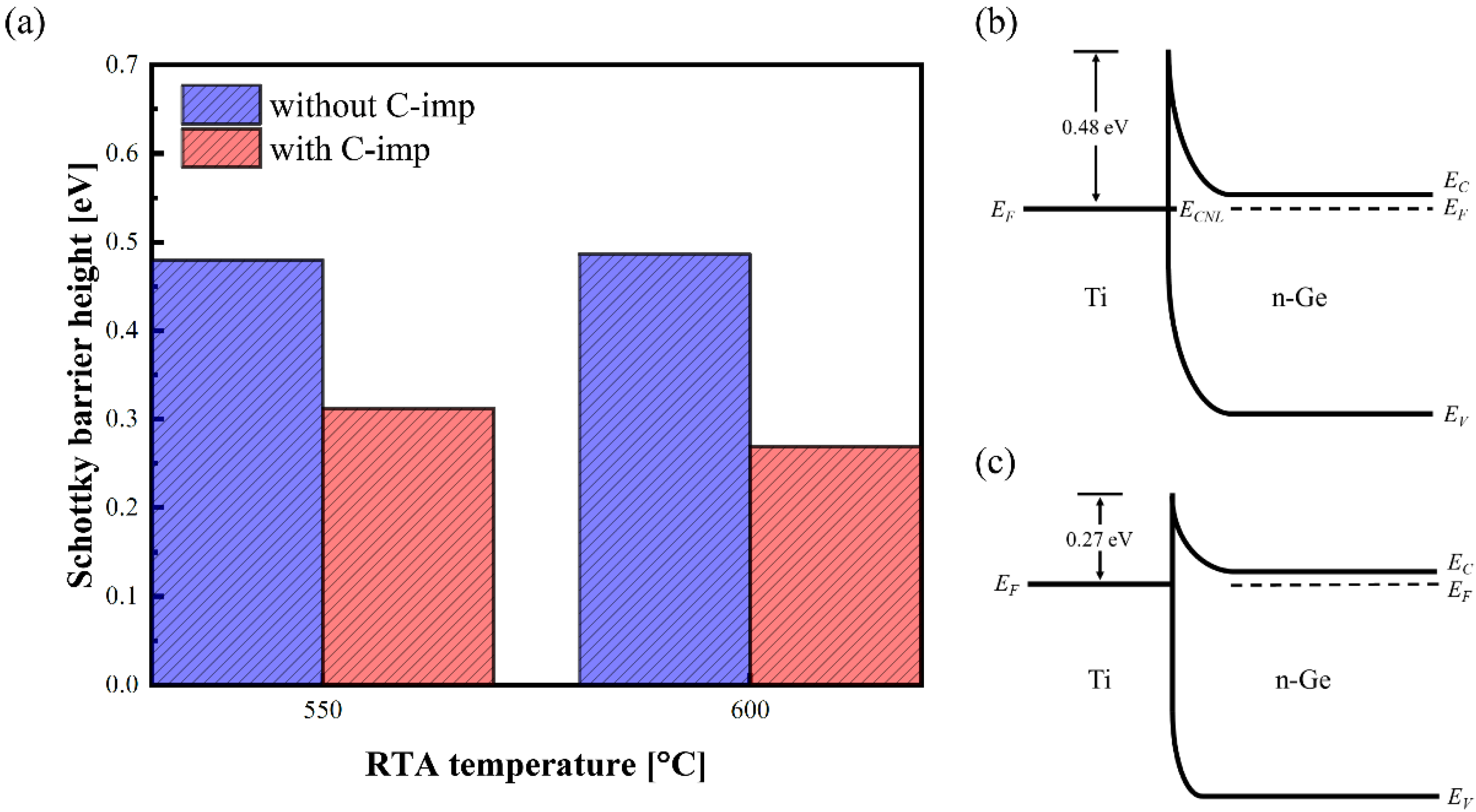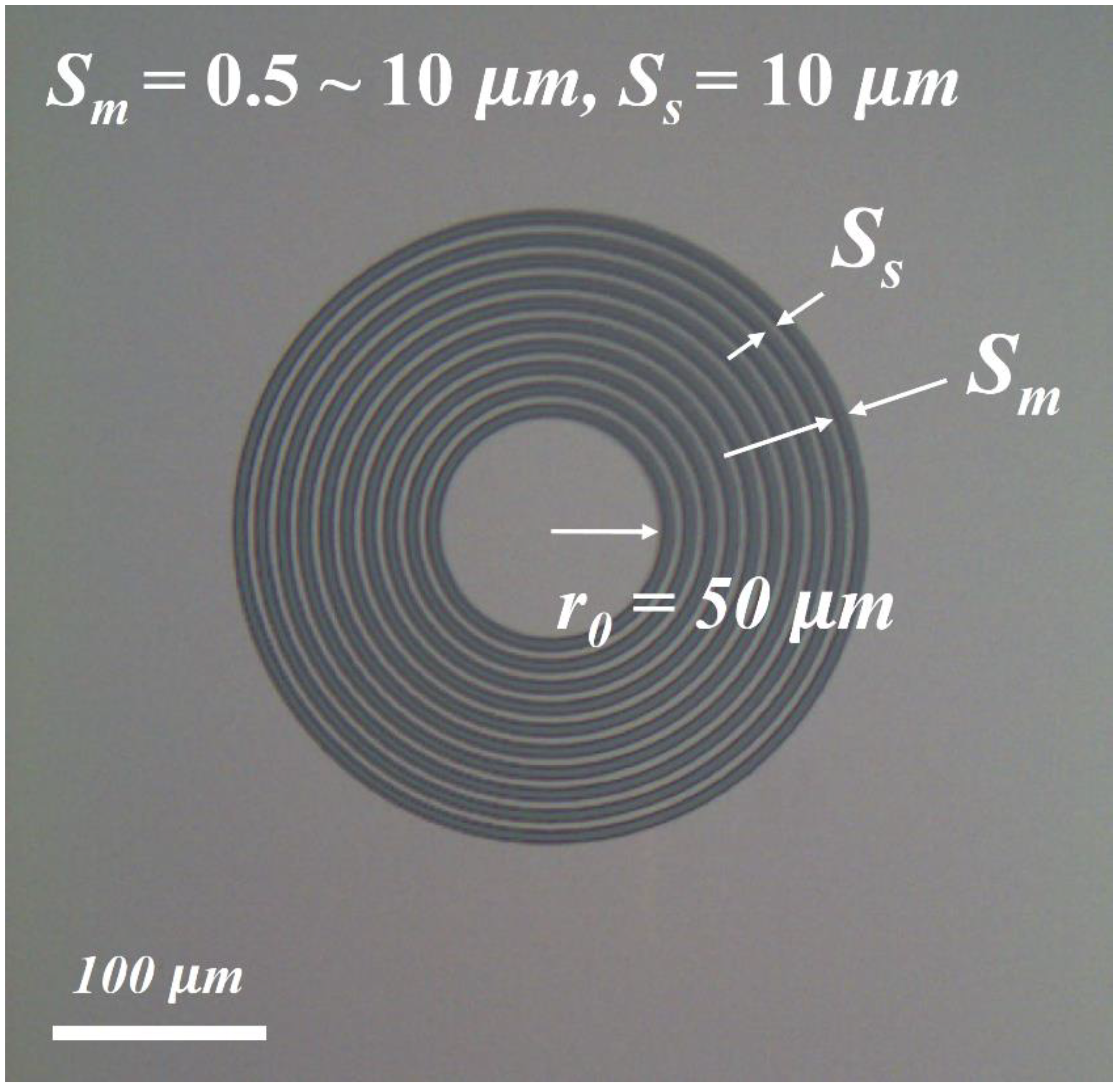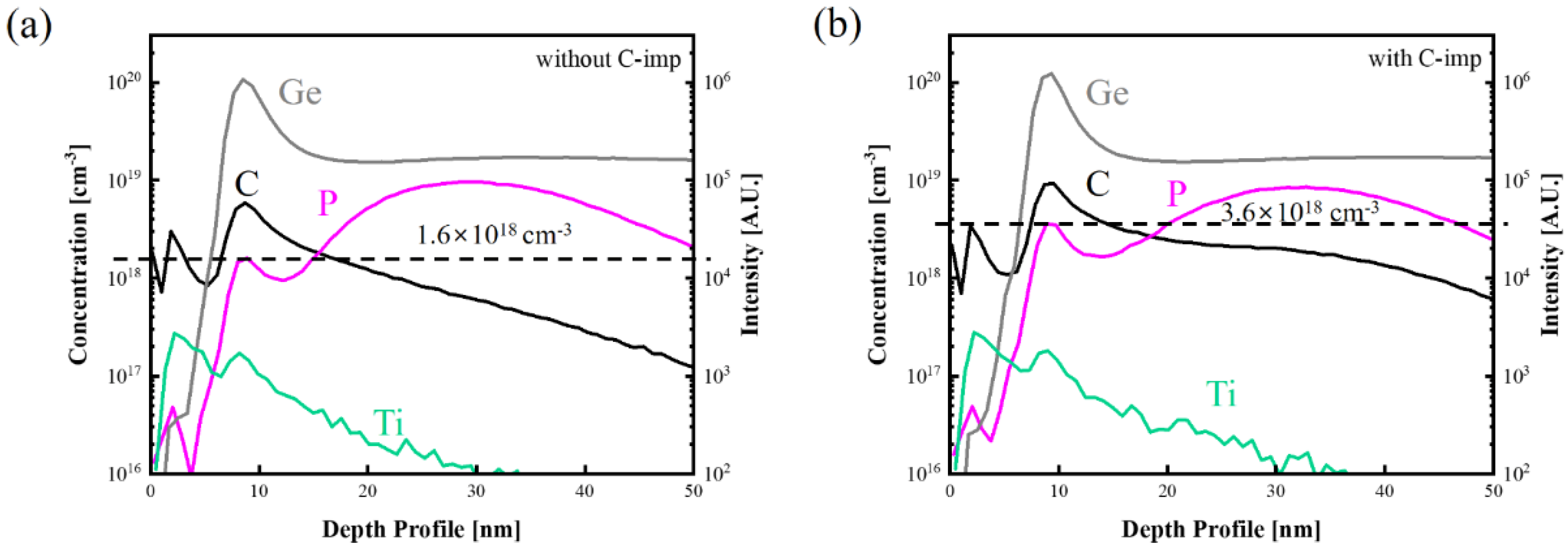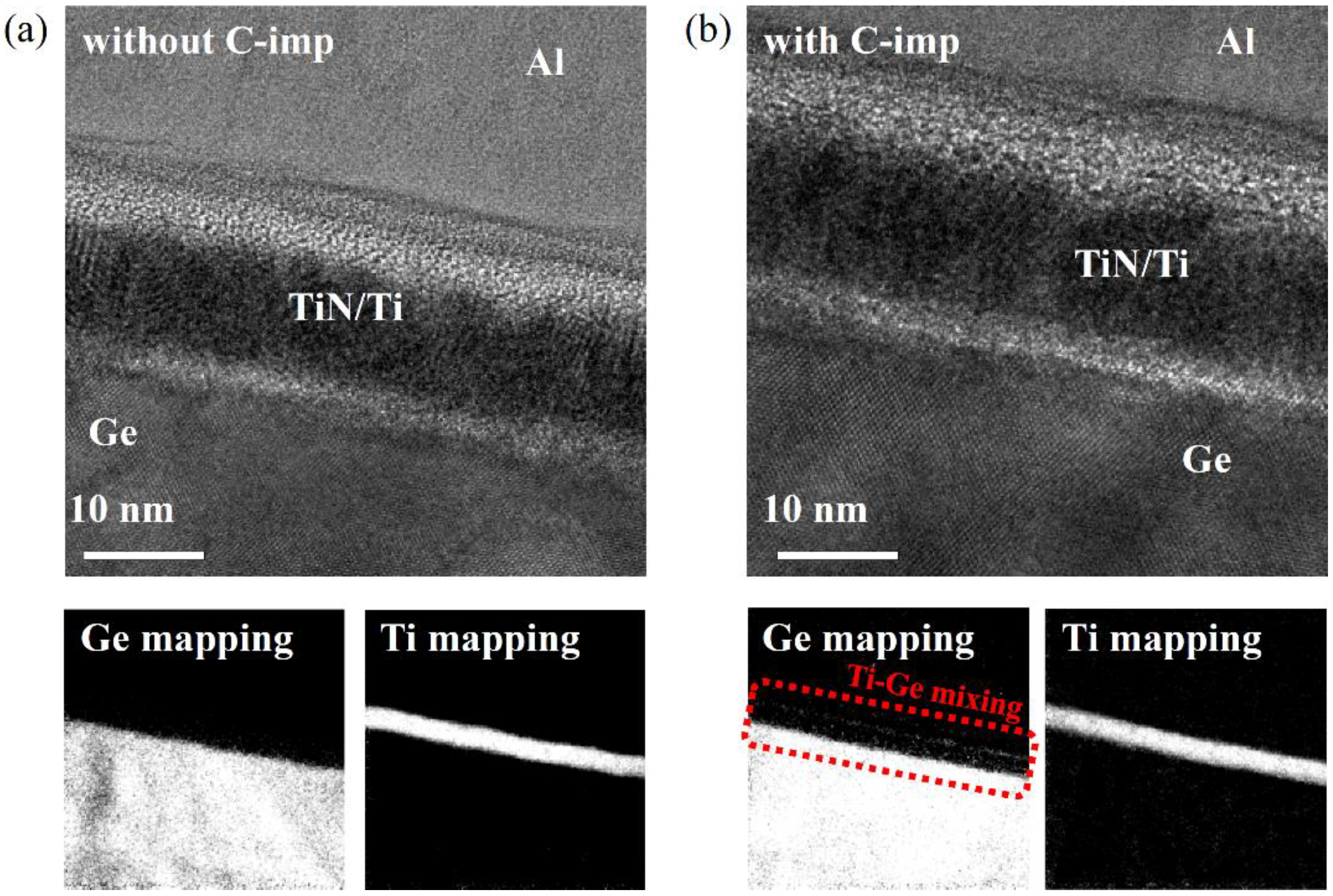Improvement of Fermi-Level Pinning and Contact Resistivity in Ti/Ge Contact Using Carbon Implantation
Abstract
:1. Introduction
2. Materials and Methods
3. Results
4. Conclusions
Author Contributions
Funding
Conflicts of Interest
References
- Simoen, E.; Claeys, C. Germanium-Based Technologies, 1st ed.; Elsevier: Oxford, UK, 2007; pp. 67–96. [Google Scholar]
- Mönch, W. Barrier heights of real Schottky contacts explained by metal-induced gap states and lateral inhomogeneities. J. Vac. Sci. Technol. B 1999, 17, 1867–1876. [Google Scholar] [CrossRef]
- Nishimura, T.; Kita, K.; Toriumi, A. Evidence for strong Fermi-level pinning due to metal-induced gap states at metal/germanium interface. Appl. Phys. Lett. 2007, 91, 123123. [Google Scholar] [CrossRef]
- Tersoff, J. Schottky barriers and semiconductor band structures. Phys. Rev. B 1985, 32, 6968–6971. [Google Scholar] [CrossRef] [PubMed]
- Robertson, J.; Guo, Y.; Zhang, Z.; Li, H. Extending the metal-induced gap state model of Schottky barriers. J. Vac. Sci. Technol. B 2020, 38, 042208. [Google Scholar] [CrossRef]
- Dimoulas, A.; Tsipas, P.; Sotiropoulos, A.; Evangelou, E.K. Fermi-level pinning and charge neutrality level in germanium. Appl. Phys. Lett. 2006, 89, 252110. [Google Scholar] [CrossRef]
- Tong, Y.; Liu, B.; Lim, P.S.Y.; Yeo, Y. Selenium Segregation for Effective Schottky Barrier Height Reduction in NiGe/n–Ge contacts. IEEE Electron Device Lett. 2012, 33, 773–775. [Google Scholar] [CrossRef]
- Wang, J.; Huang, W.; Xu, J.; Li, J.; Huang, S.; Li, C.; Chen, S. Schottky barrier height modulation effect on n-Ge with TaN contact. Mater. Sci. Semicond. Process. 2019, 91, 206–211. [Google Scholar] [CrossRef]
- Kim, G.; Kim, J.; Kim, S.; Jo, J.; Shin, C.; Park, J.; Saraswat, K.C.; Yu, H. Specific Contact Resistivity Reduction Through Ar Plasma-Treated TiO2−x Interfacial Layer to Metal/Ge Contact. IEEE Electron Device Lett. 2014, 35, 1076–1078. [Google Scholar] [CrossRef]
- Yang, J.C.; Huang, H.F.; Li, J.H.; Lee, Y.J.; Wang, Y.H. Nitrogen plasma treatment of a TiO2 layer for MIS ohmic contact on n-type Ge substrate. Vacuum 2020, 171, 108996. [Google Scholar] [CrossRef]
- Shine, G.; Saraswat, K. Analysis of Atomistic Dopant Variation and Fermi Level Depinning in Nanoscale Contacts. IEEE Trans. Electron Devices 2017, 64, 3768–3774. [Google Scholar] [CrossRef]
- Agrawal, A.; Lin, J.; Zheng, B.; Sharma, S.; Chopra, S.; Wang, K.; Gelatos, A.; Mohney, S.; Datta, S. Barrier height reduction to 0.15 eV and contact resistivity reduction to 9.1 × 10−9 Ω-cm2 using ultrathin TiO2−x interlayer between metal and silicon. In Proceedings of the 2013 Symposium on VLSI Technology, Kyoto, Japan, 11–13 June 2013; pp. 200–201. [Google Scholar]
- Dev, S.; Meena, M.; Vardhan, P.; Lodha, S. Statistical Simulation Study of Metal Grain-Orientation-Induced MS and MIS Contact Resistivity Variability for 7-nm FinFETs. IEEE Trans. Electron Devices 2018, 65, 3104–3111. [Google Scholar] [CrossRef]
- Lin, L.; Guo, Y.; Robertson, J. Metal silicide Schottky barriers on Si and Ge show weaker Fermi level pinning. Appl. Phys. Lett. 2012, 101, 052110. [Google Scholar] [CrossRef]
- Zhang, Z.; Guo, Y.; Robertson, J. Origin of Weaker Fermi level Pinning and Localized Interface States at Metal Silicide Schottky Barriers. J. Phys. Chem. C 2020, 124, 19698–19703. [Google Scholar] [CrossRef]
- Yu, H.; Schaekers, M.; Rosseel, E.; Peter, A.; Lee, J.-G.; Song, W.-B.; Demuynck, S.; Chiarella, T.; Ragnarsson, L.-A.; Kubicek, S.; et al. 1.5 × 10−9 Ω·cm2 Contact Resistivity on Highly Doped Si:P Using Ge Pre-amorphization and Ti Silicidation. In Proceedings of the 2015 IEEE International Electron Devices Meeting (IEDM), Washington, DC, USA, 7–9 December 2015. [Google Scholar]
- Park, I.; Seol, J.-B.; Yoon, G.; Lee, J.-S. Three-dimensional imaging of carbon clusters in thermally stable nickel silicides by carbon pre-implantation. Appl. Surf. Sci. 2021, 539, 148152. [Google Scholar] [CrossRef]
- Duan, N.; Luo, J.; Wang, G.; Liu, J.; Simoen, E.; Mao, S.; Radamson, H.; Wang, X.; Li, J.; Wang, W.; et al. Reduction of NiGe/n- and p-Ge Specific Contact Resistivity by Enhanced Dopant Segregation in the Presence of Carbon During Nickel Germanidation. IEEE Trans. Electron Devices 2016, 63, 4546–4549. [Google Scholar] [CrossRef]
- Schroder, D.K. Semiconductor Material and Device Characterization, 3rd ed.; John Wiley & Sons: Hoboken, NJ, USA, 2015. [Google Scholar]
- Yu, H.; Schaekers, M.; Schram, T.; Rosseel, E.; Martens, K.; Demuynck, S.; Horiguchi, N.; Barla, K.; Collaert, N.; De Meyer, K. Multiring Circular Transmission Line Model for Ultralow Contact Resistivity Extraction. IEEE Electron Device Lett. 2015, 36, 600–602. [Google Scholar] [CrossRef] [Green Version]
- Ahn, H.J.; Moon, J.; Seo, Y.; Lee, T.I.; Kim, C.-K.; Hwang, W.S.; Yu, H.-Y.; Cho, B.J. Formation of low-resistivity nickel germanide using atomic layer deposited nickel thin film. IEEE Trans. Electron Devices 2017, 64, 2599–2603. [Google Scholar] [CrossRef]
- Chou, C.; Tsai, Y.; Hsu, C.; Jau, Y.; Lin, Y.; Yeh, W.; Chien, C. Experimental realization of thermal stability enhancement of nickel germanide alloy by using TiN metal capping. IEEE Trans. Electron Devices 2017, 64, 2314–2320. [Google Scholar] [CrossRef]
- Ku, K.C.; Nieh, C.F.; Gong, J.; Huang, L.P.; Sheu, Y.M.; Wang, C.C.; Chen, C.H.; Chang, H.; Wang, L.T.; Lee, T.L.; et al. Effects of germanium and carbon coimplants on phosphorus diffusion in silicon. Appl. Phys. Lett. 2006, 89, 112104. [Google Scholar] [CrossRef] [Green Version]
- Lai, J.B.; Chen, L.J. Effects of composition on the formation temperatures and electrical resistivities of C54 titanium germanosilicide in Ti-Si1−xGex systems. J. Appl. Phys. 1999, 86, 1340–1345. [Google Scholar] [CrossRef]






Publisher’s Note: MDPI stays neutral with regard to jurisdictional claims in published maps and institutional affiliations. |
© 2022 by the authors. Licensee MDPI, Basel, Switzerland. This article is an open access article distributed under the terms and conditions of the Creative Commons Attribution (CC BY) license (https://creativecommons.org/licenses/by/4.0/).
Share and Cite
Park, I.; Lee, D.; Jin, B.; Kim, J.; Lee, J.-S. Improvement of Fermi-Level Pinning and Contact Resistivity in Ti/Ge Contact Using Carbon Implantation. Micromachines 2022, 13, 108. https://doi.org/10.3390/mi13010108
Park I, Lee D, Jin B, Kim J, Lee J-S. Improvement of Fermi-Level Pinning and Contact Resistivity in Ti/Ge Contact Using Carbon Implantation. Micromachines. 2022; 13(1):108. https://doi.org/10.3390/mi13010108
Chicago/Turabian StylePark, Iksoo, Donghun Lee, Bo Jin, Jungsik Kim, and Jeong-Soo Lee. 2022. "Improvement of Fermi-Level Pinning and Contact Resistivity in Ti/Ge Contact Using Carbon Implantation" Micromachines 13, no. 1: 108. https://doi.org/10.3390/mi13010108
APA StylePark, I., Lee, D., Jin, B., Kim, J., & Lee, J.-S. (2022). Improvement of Fermi-Level Pinning and Contact Resistivity in Ti/Ge Contact Using Carbon Implantation. Micromachines, 13(1), 108. https://doi.org/10.3390/mi13010108






